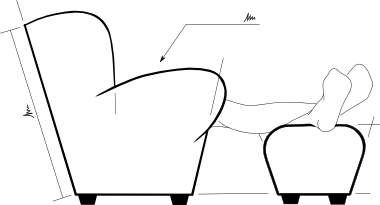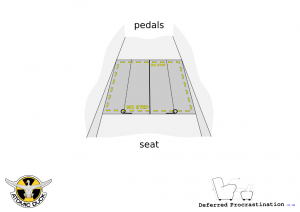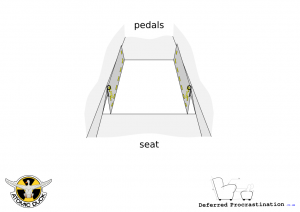Going backwards
Velomobiles go forwards really well (better than an upright bike and a recumbent!) but they aren’t well suited to going backwards. It’s a probem that comes from sharing driveline components with bicycles.
Bicycles don’t have a reverse gear for the same reasons motorbikes don’t: going backwards while balancing on two wheels is difficult–more difficult than going forwards; and they are light enough to be pushed (scooted) backwards for the small number of times they need to be reversed[1].
On open recumbents, the lack of a reverse gear has little impact on normal usage. Being light and with open access to the ground, it’s no more difficult to scoot a recumbent backwards than to do so on an upright bike. However, as soon as you enclose the recumbent to make it a velomobile, you stop the rider being able to reach the ground.
Resolving the problem of reversing in velomibiles has four main options:
-
Ignore the problem and have no reverse. You won’t need to go backwards very often anyway, and you can always just get out and push!
-
Have a hole in the floor, so you can put your feet down and scoot. This will add some drag though, and it can allow road dirt and water in–negating some of the advantave of having a velomobile.
-
Use your electric assist motor/hub generator to give you electric reverse at the push of a button. Although if you don’t have this already, it adds extra weight and cost.
-
Forgo a wide gearing range and the ability to freewheel (coast without the pedals moving) and have a fixed gear hub. You can pedal backwards to reverse, but it will be harder to start and climb because it only has a single gear.
For Atomic Duck, I don’t think the first option is suitable because it is to be designed as a practical, everyday vehicle. The TriSled SuperVelo has optional cut-outs in the floor so, without them, it has better aerodynamic efficency for maximum performance. They are recommended though, for road use.
Having only electric reverse is also not suitable for Atomic Duck. The additional weight, cost and complexity is an unnecessary requirement (though it is suitable as an option). And, for good design, it should still be possible to reverse the velomobile even if there is no power in the battery. In short: a human powered vehicle should be able to operate normally, by human power alone.
I am interested to know if fixed gearing could be suitable on a velomobile. I suspect that it would be perfectly rideable, and remove the need for a rear foot-brake (see: Stopping an Atomic Duck). Though I’d like to at least try it, I do think that there are very few velomobilers or recumbent riders that would be willing to give up gears.
Have you ridden a fixed gear recumbent? What was it like to ride?
That leaves only a hole in the floor as a viable option. To increase comfort in the Atomic Duck, having a hinged door means the floor will be closed most of the time when riding, but can be opened on the few occasions that the rider needs to push themselves in reverse.
This also means that if the owner chooses to have electric drive/generation, the electric reverse can be used normally, with the option to use the “manual” reversing mechanism, and still have a closed floorpan.
[1] - A reverse gear is an option on some Honda Goldwing models. My (minimal) research seems to suggest the starter motor drives the gearbox in reverse with the engine disconnected. References: goldwingowners.com/forums and bbs.trikes.org.



Opus the Poet wrote, “Well for gears and a fixed hub you can use the S-A fixed 3-speed hub, but I don't know that it would have a wide enough range for efficient use on a VM. I planned on using a hub motor from the get-go on mine with a reversing controller and a solid floorboard to keep the water out. My mission for my VM is a series of 300 mile days cross country with the hub motor picking up the slack for hills so as to maintain a 20 MPH average no matter what the terrain. ;)”